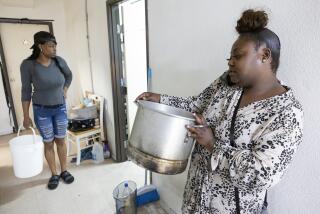‘It Is Good That They Have Found Us a New Place,’ Squatter Says : ‘Orderly Urbanization’--S. Africa Eases Resettlement
JOHANNESBURG, South Africa — When the big white government trucks pulled into the squatter settlement at Varkfontein farm, residents were already pulling apart their shacks of plywood, tin, plastic sheeting and scrap lumber, ready to move in a voluntary--and unusual--resettlement of black squatters in South Africa.
“This place is very dirty and unhealthy,” Christina Tsolo said, watching as her neighbors began loading their clothes, furniture and other possessions onto the trucks along with the “makings” of their shanties. “At least at the new place, we can start again and build proper houses . . . I think it is better that we go.”
The smooth resettlement over the past two weeks of more than 2,500 squatters from the farm near Bapsfontein, northeast of Johannesburg, to a new section of Daveyton, a large black township east of the city, resolved what might have become an angry confrontation between blacks determined to remain near their urban jobs and government officials intent on preventing the influx of more rural blacks.
‘Here It Is Very Bad’
“It is good that they have found us a new place,” another of the shantytown residents, John Radebe, 37, said, “because here it is very bad.”
The journey to Daveyton, in fact, was only a few miles down the road, but after decades of “influx control” meant to restrict the growth of black urban settlements, the government’s readiness to find a new site for the squatters was an important test of its declared policy of “orderly urbanization.”
“The people were happy to move,” said Jan van der Walt, the Transvaal provincial director of land use control. “We were moving a limited number of people each day, and additional families came and begged to be moved, saying they did not want to wait.”
Severe Housing Shortage
The Varkfontein camp, like dozens of squatter settlements that have sprung up around the country in the past year, was filled with families, many young but others already at pension age, who had nowhere else to go. Some had moved off other farms to seek better-paying city jobs, others had come from the overcrowded black ghettos around Johannesburg and Pretoria and still others had fled riot-torn areas.
A white farmer, Giel Nieuwoudt, leased them little patches of what used to be a cow pasture to build their shacks--in violation, a court later found, of South African laws prohibiting blacks from living in areas zoned for whites only. Nieuwoudt made a small fortune by collecting about $15 a month from as many as a thousand families in his field.
“Why should they have to move?” Nieuwoudt asked as government trucks took away his tenants under army supervision. “They don’t want to because they are going to pay more at this other place, and most can’t afford it.”
In the past, most of the tenants, particularly those from rural areas, would have been forced to return to their previous homes, but since July, 1986, blacks have been permitted under one of the government’s most important reforms to move and settle where they wish, provided they could find housing.
But the housing shortage is severe--blacks need 200,000 new units a year and only 25,000 are built on average--and the draw of the cities has been so great that people are building shacks wherever they can. South Africa’s squatters are officially estimated at 1.3 million, and it could be twice that, or a tenth of the country’s black population.
“People cannot just move onto land that does not belong to them or that has been earmarked for some sort of development and put up a shack and live,” an official of the Department of Constitutional Development and Planning said, explaining the government’s unhappiness with the growing number of squatters. “They must have permission to live in a particular place.
“The government has now appointed specialists to look into the possibility of identifying land for orderly urbanization. . . . This will give real significance to the lifting of influx control last year.”
Moving the Varkfontein camp was one of the first tests of this policy, and government officials quickly found new space for the squatters, advancing Daveyton the money to buy a neighboring farmer’s bean fields if it took in most of the squatters.
Plans to Add Housing
“This is not a removal in the true sense,” Van der Walt said, rejecting any comparison with the government’s forced removals of such “black spots” from white areas in the past. “The people are simply making use of our offer to move their belongings. People had complained about unhygienic conditions there, and the farmer (Nieuwoudt) was prosecuted.”
With a $3 million loan from Transvaal province, Daveyton plans not only to give the squatters housing sites with water and sewer lines but to provide land for 16,000 of its own families now living in shacks in the backyards of older houses in the township. Plans are also being drawn up for $12.5 million in housing, probably basic units made of concrete blocks that residents then adapt and build on, for this new section of the township.
“When you have a housing shortage--more than 1 million units nationwide--as severe as ours, you cannot speak of a breakthrough,” Daveyton Mayor Tom Boya commented, “but maybe we can speak of it as a start at solving the problem, at least for Daveyton.”
More to Read
Sign up for Essential California
The most important California stories and recommendations in your inbox every morning.
You may occasionally receive promotional content from the Los Angeles Times.










